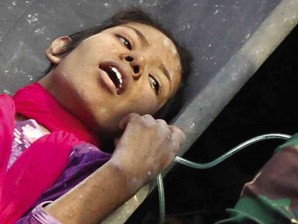Woman rescued; 16 days under rubble

A MIRACLE Reshmi out of the ruins of a garment factory in Savar, Bangladesh, on Friday. Death toll now stands at 1,041. AFP
SAVAR, Bangladesh—A woman was pulled alive on Friday from the ruins of a garment factory complex in Bangladesh more than 16 days after it collapsed and killed more than 1,000 people.
The miraculous rescue came shortly after emergency officials announced that the woman called Reshmi had been located under the rubble of the nine-story Rana Plaza complex after crying out for help.
A report on Bangladesh’s Somoy TV said that she had been found sheltering in the ruins of a basement mosque.
Rescuers cheered loudly as she was carried to an army ambulance, managing a faint smile at the crowds who had gathered.
The country’s fire service chief told Agence France-Presse that the woman appeared to have had access to water during her marathon ordeal trapped underneath the wreckage of the nine-story Rana Plaza complex, which caved in on April 24.
Article continues after this advertisementCry for help
Article continues after this advertisement“She has been located in a gap between a beam and a column. Her name is Reshmi. She may have reserves of water or have drunk some of the water that we’ve pumped into the building,” Ahmed Ali told AFP.
One of the rescuers said that the woman had cried out for help as recovery teams sifted through the wreckage in the town of Savar on the outskirts of the capital Dhaka.
“As we were clearing rubble, we called out if anyone was alive,” the unnamed rescuer told the private Somoy TV channel. “Then we heard her saying ‘please save me, please save me.’”
Another rescuer said that the woman had had access to food supplies for the first fortnight of her ordeal but had run out two days ago.
“She said she has not eaten for the last two days. She said she has eaten some dried food like biscuits,” the rescuer said. “She said she had found a safe place and found some air and light.”
Death toll: 1,041
News of the miracle survival came as recovery teams were preparing to wrap up their work at the site after discovering scores more corpses in the tangle of concrete overnight.
Brig. Gen. Siddiqul Alam, one of the leaders of the recovery operation, said the toll now stands at 1,041, making it one of the world’s deadliest industrial disasters.
Alam said many of the bodies were little more than skeletons and the stench from under the rubble suggested that many more were still to be located.
“We have found a huge number of bodies in the stairwell and under the staircases. When the building started to collapse, workers thought they would be safe under the staircases,” he said.
“Each time we moved a slab of concrete, we found a stack of bodies,” he said.
April 24 disaster
More than 3,000 workers were on shift on the morning of April 24 when the building suddenly caved in.
Most were earning around $40 a month to make clothing for Western brands such as Italy’s Benetton, Britain’s Primark and the Spanish label Mango.
Efforts to identify victims have been hampered by the decomposition of bodies, although some were found with mobile phones in their pockets or identity cards around their necks.
The preliminary findings of a government probe blamed vibrations from four giant generators on the upper floors for triggering the collapse.
String of disasters
Police have arrested 12 people, including the plaza’s owner and four factory bosses, for forcing people to work on the day of the disaster, even though cracks appeared in the structure the day before.
The collapse was the latest in a string of disasters to blight the textile industry, with a factory fire last November killing 111 workers.
A fire at a textile factory in Dhaka on Thursday killed eight people, including its owner.
Bangladesh is the world’s second-largest apparel maker and the $20-billion industry accounted for up to 80 percent of annual exports last year.
But it has a shocking safety record and Western retailers have been threatening to pull out unless authorities come up with a credible program to raise standards in the 4,500 factories. Disney has already done so.